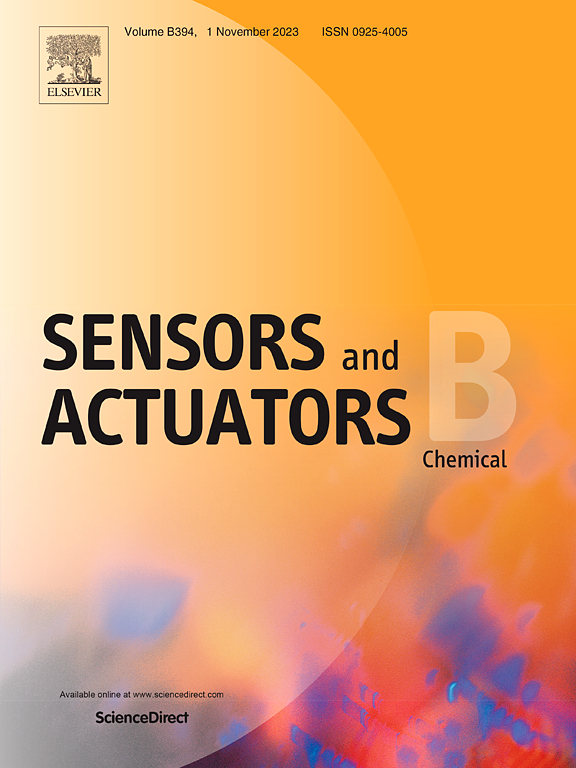辅酶A对Ag(I)催化的非竞争性抑制:检测胃癌循环肿瘤细胞组蛋白乙酰转移酶活性的新策略
IF 8
1区 化学
Q1 CHEMISTRY, ANALYTICAL
引用次数: 0
摘要
本研究介绍了一种利用辅酶a (CoA)介导的银离子(Ag(I))催化的非竞争性抑制来检测胃癌循环肿瘤细胞(ctc)中组蛋白乙酰转移酶(HAT)活性的新方法。对CoA、Ag(I)和显色底物3,3',5,5'-四甲基联苯胺(TMB)之间的相互作用进行了彻底的研究,从而开发了一种高灵敏度和特异性的HAT检测方法。值得注意的是,该方法利用Ag(I)催化TMB的氧化,不需要H₂O₂,简化了反应体系。我们的研究结果表明,CoA以一种非竞争性的方式有效地抑制了Ag(I)的催化活性,为量化ctc中HAT活性提供了一种可靠的方法。利用紫外可见光谱和基于智能手机的RGB平台,该方法具有良好的选择性和灵敏度,检出限为0.033 ng/mL (S/N=3)。综合分析各种细胞类型,包括正常细胞、胃癌细胞和模拟CTCs,发现HAT活性在CTCs中最高,在一定程度上强调了它们在肿瘤转移中的关键作用。此外,表皮生长因子(EGF)和肿瘤坏死因子-α (TNF-α)刺激在不同细胞中显示出不同的HAT活性模式,突出了它们对生长和炎症信号的不同反应。该方法还可以通过改变金属离子和抑制成分来适应其他生物传感平台,显示其在癌症诊断和转移监测方面的多功能性和潜在的实际应用。本文章由计算机程序翻译,如有差异,请以英文原文为准。

Non-competitive inhibition of Ag(I) catalysis by coenzyme A: A novel strategy for detecting histone acetyltransferase activity in gastric cancer circulating tumor cells
This study introduces a novel method for detecting histone acetyltransferase (HAT) activity in gastric cancer circulating tumor cells (CTCs) by leveraging coenzyme A (CoA)-mediated non-competitive inhibition of silver ion (Ag(I)) catalysis. The interactions between CoA, Ag(I), and the chromogenic substrate 3,3′,5,5′-tetramethylbenzidine (TMB) were thoroughly examined, leading to the development of a highly sensitive and specific assay for HAT detection. Notably, this method utilizes Ag(I) to catalyze the oxidation of TMB without the need for H₂O₂, simplifying the reaction system. Our results show that CoA effectively inhibits the catalytic activity of Ag(I) in a non-competitive fashion, offering a robust means to quantify HAT activity in CTCs. By utilizing UV-Vis spectroscopy and a smartphone-based RGB platform, this method exhibited remarkable selectivity and sensitivity, with a detection limit of 0.033 ng/mL (S/N = 3). Comprehensive analysis across various cell types, including normal cells, gastric cancer cells, and simulative CTCs, revealed that HAT activity was highest in CTCs, underscoring their critical role to some extent in tumor metastasis. Furthermore, stimulation with epidermal growth factor (EGF) and tumor necrosis factor-α (TNF-α) demonstrated distinct HAT activity patterns in different cells, highlighting their differential responses to growth and inflammatory signals. This method can also be adapted to other biosensing platforms by altering metal ions and inhibitory components, showcasing its versatility and potential for real-world applications in cancer diagnostics and metastasis monitoring.
求助全文
通过发布文献求助,成功后即可免费获取论文全文。
去求助
来源期刊

Sensors and Actuators B: Chemical
工程技术-电化学
CiteScore
14.60
自引率
11.90%
发文量
1776
审稿时长
3.2 months
期刊介绍:
Sensors & Actuators, B: Chemical is an international journal focused on the research and development of chemical transducers. It covers chemical sensors and biosensors, chemical actuators, and analytical microsystems. The journal is interdisciplinary, aiming to publish original works showcasing substantial advancements beyond the current state of the art in these fields, with practical applicability to solving meaningful analytical problems. Review articles are accepted by invitation from an Editor of the journal.
 求助内容:
求助内容: 应助结果提醒方式:
应助结果提醒方式:


